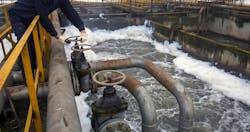Next to energy for power, water is one of the most important resources for the process manufacturing industry. Water quality is critical for utility water, such as cooling water, and for water used in the manufacturing process itself. At the end of production, processed water becomes wastewater that must be treated before it can be discharged from the plant. Engineers must use advanced separation techniques to ensure the quality of water is correct, sometimes down to the concentration of a few nanograms per liter.
In fact, the environmental challenges of wastewater treatment are significant. For instance, 3 percent of global electricity consumption is for wastewater treatment, and it contributes to 1.6 percent of global greenhouse gas emissions. Meanwhile, wastewater treatment plants must clean increasingly polluted water coming into the plant and meet stricter regulations for the quality of water exiting the plant. Thus, it is critical to find sustainable and cost-effective solutions to achieve these goals.
Using data to predict
One of the ways companies can reduce the environmental consequences of wastewater treatment is by determining the right time to perform maintenance on critical assets. Completing maintenance before a problem occurs not only can save energy, but it also could prevent a plant shutdown. Companies can use predictive analytics to explore operational data and find the right time to clean or repair equipment.
While creating data models for analysis is the domain of central data analysis teams, operational experts generally have the skillset necessary to shorten the time it takes to learn process behavior and overcome anomalies. Using advanced industrial analytics software can help them determine when they need to perform regular maintenance.
The following examples demonstrate how operational data can be used to predict the right time to perform maintenance to reduce wastewater treatment costs and achieve corporate sustainability goals.
Reducing pump shutdowns
Pumps are an integral part of the wastewater treatment process. They move massive amounts of water. Keeping pumps operational is necessary to ensure water treatment processes remain online. Serious problems can occur when a critical pump breaks.
One wastewater treatment facility struggled with pump failures. Operational experts needed a better way to know which pumps were online and which had failed. They understood that periods of high pump vibrations could correlate with pump failures, so they wanted to monitor the pumps and search operational data for periods when the vibration was high.
Using advanced industrial analytics software, engineers were able to monitor all the pumps on a dashboard, as shown in Figure 1. They then were able to identify the golden fingerprint, which excluded periods of high pump vibrations. Moreover, they set up alerts that notified key personnel when a pump was about to shut down.
During periods of high vibrations, operational experts now receive alters that the pumps are operating outside their golden fingerprint. This allows them to intervene and smooth out pump vibrations in time to stop a shutdown. Engineers also made a Gantt chart for an overview of the pump runs over the course of time. This way, they know which are running, which have malfunctioned and how often pumps have problems.
Cleaning aeration elements
The biological wastewater treatment step is the largest energy consumer of all process steps at a wastewater treatment plant. The treatment is a complex interaction, which can be very sensitive to change of pH, oxygen concentration in the water and temperature.
Engineers at a wastewater treatment plant wanted to improve their maintenance schedule for biological aeration elements. Because the elements suffer from fouling, they need to be cleaned regularly. Oxygen concentration decreases when aeration elements are fouled, and the treatment no longer works efficiently.
The goal was to transition to a predictive maintenance schedule when the aeration elements would be cleaned before performance started to degrade. However, various effluents in the water and other variables can affect the duration between cleanings.
Wastewater treatment plants must overcome high-input variances of incoming wastewater, which can vary depending on the time of day, the time of year and weather conditions. Engineers need the information associated with those changes to schedule predictive maintenance. Therefore, getting a clear indication that the elements needed to be cleaned was extremely difficult.
To overcome this challenge, operational experts created tags to correspond with oxygen concentrations over time. They then created a dashboard, as shown in Figure 2, that allowed them to see all the oxygen concentrations across the various aeration elements. When the oxygen concentration drops during the nitrification process, then engineers know the aeration elements need to be cleaned.
The monitors allowed engineers to take a “just-in-time” approach that saved money in maintenance and energy costs.
Conclusion
Water treatment is critical in the process manufacturing industry. It also is energy-intensive, has a high carbon footprint and is subjected to increasingly challenging water quality and stricter regulations on water discharge. Companies must find sustainable and cost-effective solutions to reduce the environmental impact of water treatment while maintaining quality and complying with regulations.
By using operational data and advanced industrial analytics software, companies can reduce the environmental consequences of wastewater treatment. In addition to finding the right time to perform critical maintenance, advanced industrial analytics empowers operational experts to explore data for clues that help them make a variety of operational improvements that can have a positive effect on the environment.
Louis Nitzschke is a Data Analytics Engineer and member of the water industry expert group at TrendMiner where he helps process manufacturing companies find potential benefits hidden in operational data. Louis earned his bachelor’s degree in chemical engineering and biochemical engineering from the Technical University of Hamburg in Germany.
TrendMiner




